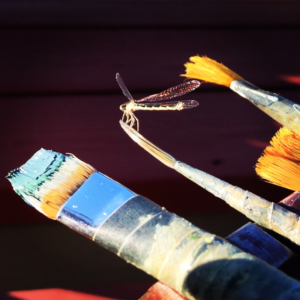
A study done on location at Thoreson Farm inside Sleeping Bear National Park.
We’re on to the fourth and final week!
Color, oh glorious color. We’ve been waiting for you. Each week has built on the previous week. If you’re just tuning in now, it is important to go back and build your powers of observation, starting at Week #1.

Driftwood study done on the shores of Lake Michigan inside Sleeping Bear National Lake Shore.
So far, we have learned how to really see: to notice details like the relationship of one object to another spatially, to observe lines and color value. Now, to put it all together to do color studies.
These are not meant to be completed paintings, but more of color notes you can quickly do on location. These, along with your observation notes and sketches, can be put together to do a more complete work in the studio, or you can let them stand alone as artworks in their own right.
This week, we are going to use the paint of your choice. Anything that marks down color will work. I’m going to be using oil paint because that is the medium I am most comfortable with currently.
The first step is to get outside. Bring your supplies with you. I’ll be using my pochade box and oil paints. I use water-mixable oil paints, so I’ll need water, brushes and paper towels to clean my brushes. And, of course, a canvas. I use flat paint panels for ease.

The unexpected joy of working outside.
Now you can use all of the skills you’ve learned so far. First, choose your subject. Then observe. Use your notebook to write down what you see, hear, smell and feel. Then sketch it out, including value. Choose what is most interesting or important to you about the scene and record it with words and sketching. Be sure to include the darkest and lightest values.
Got it? Great! You’re ready to make color notes. Squint your eyes to see basic shapes and values and lay the sky down first, if there is a sky in your scene. Then, block in the shapes, starting with the darkest. Do not worry about any details now. This is the time your painting should look like a paint by number, with very quick shapes and values recorded.
The benefit of working from nature is the amazing amount of information in front of you. Make “notes” with your paint about that information. It is more important to make notes of observation than to think of a completed painting at this point. This is about being outside and burning the information into your brain, as well as using the skills you’ve acquired to make notes to jar your memory later. Or to just observe nature more carefully.

A study done on location from Sleeping Bear Heritage Trail inside Sleeping Bear National Park.
If you master these skills, the power to observe and record, you can paint anything. It does take a commitment. It does take time. But from this place, you can take creativity in a million different directions. That’s it.
To “finish” a painting beyond these color notes, this is where your individuality comes in. It’s like your handwriting on a work of art. Your personal touch. To figure out what your personal touch is, you just have to log the hours. Experiment. Play. And make art. Now do it again and again, and you’re off and running.
To really learn from this last week, you need a half hour to an hour a day. Longer is better. Nobody said it would be easy. Like learning to speak a new language or to play an instrument, painting takes time and practice. Go on, campers, you can do it — and it’s the perfect time of year!
Happy art making, and I’ll see you here again next week for more tales from the studio!
Cheers!
[vimeo 226782970 w=480 h=320]







